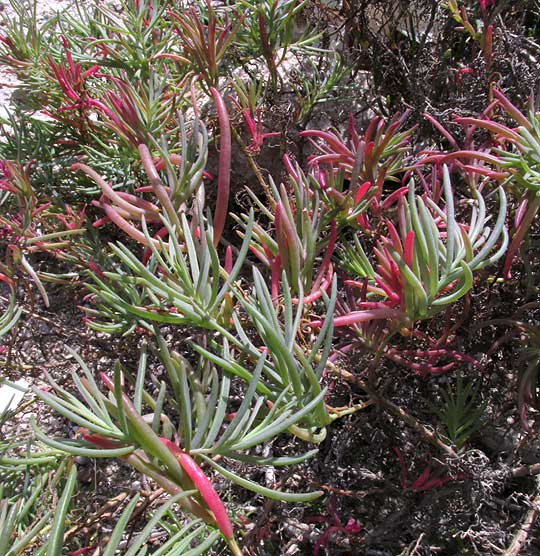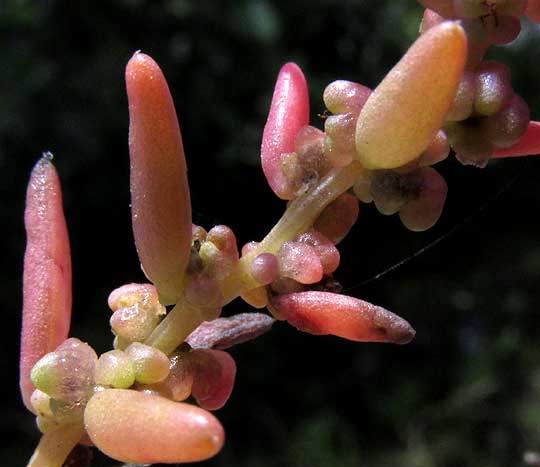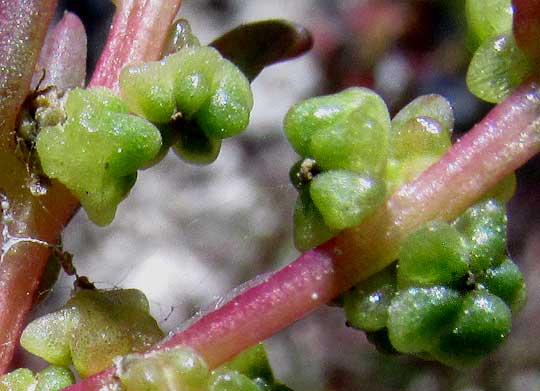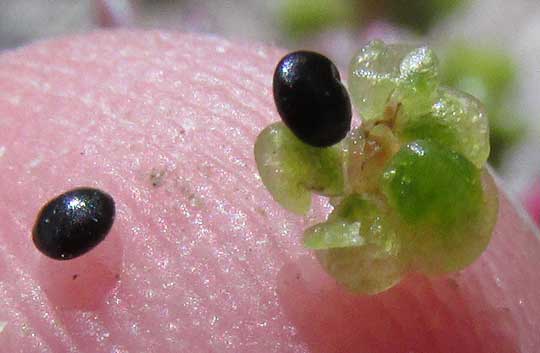Excerpts from Jim Conrad's
Naturalist Newsletter
from the February 1, 2015 Newsletter issued from Río Lagartos, on the Yucatan Peninsula's northern coast (~N21.60°, ~W88.16°), Yucatán state, MÉXICO
SEABLITE
The broad, pleasant-to-walk avenue next to the seawall encircling most of Río Lagartos is called the Malecón. On the southeastern side of town, the Malecón continues south of town, separating the estuary from adjacent mangrove swamps. In roadside rubble barely above the mangrove's salty water, a certain much branched, woody-based, sprawling, succulent-leafed, two-ft-high plant caught my eye with its reddish leaves -- this in a landscape where in general leaves don't turn bright colors as they do in autumn up north. Below, you can see the scraggly, untidy-looking plant:

Up closer, the plant exhibits more composure and comeliness, as evidenced below:

The slender, round-in-cross-section, succulent leaves are similar to other leaves of local halophytic plants in salty soils, such as Sea Purslane, Saltwort and Wolfberry. However, notice the strange feature that some of the reddish leaves elongate and swell to several times the size of others. At first I thought they must be capsular fruits but they weren't, just juicy, salty leaves that tasted pretty good when nibbled upon.
Branch tips appeared to be occupied with a kind of soft crumbliness, so out came the hand lens, and the tiny crumbs revealed specific shapes, as seen below:

Objects at the base of fingerlike leaves looked like deeply lobed ovaries of mint flowers, in which the individual lobes eventually mature into separate "nutlets" from which can sprout new plants. But I've never seen succulent nutlets. An even closer look of the items is shown below:

The thing in the picture's center, wedged between two succulent leaves, appears to be 4-lobed, exactly like a mint-flower ovary, plus in the depression where the four lobes meet there's a dark, bushy cluster that could hardly be anything but the remains of a flower's stigmas and styles. Therefore, the 4-lobed item is definitely a fruit. But notice that at the right in the picture there's another fruit, which is 5-lobed, something I've not seen in a mint flower.
After searching the tips of many branches, finally a just-opened blossom turned up, one with five stamens radiating from the flower's center, each stamen's slender filament inserted beneath a cream-colored disc, which was the expanded base of the style, known as a stylopodium. This is shown below:

Only a few plant families produce stylopodia, particularly the Parsley Family, the Apiaceae. However, this plant's flowers aren't arranged like those of the Parsley Family, in umbels, so this is getting interesting. Examining more maturing fruits, it became clear that the fruits often developed irregularly, with one to five lobes, and the lobes could be of various sizes, as seen below:

A common weed up north with branch-tip clusters of flowers that develop into spike-like heads of soft, crumbly fruits is the tasty potherb known as Lamb's Quarters, which is a member of the old Goosefoot or Spinach Family, the Chenopodiaceae, lately merged into the Amaranth Family, the Amaranthaceae. However, members of that family normally produce hard, black, egg-shaped little seeds very unlike anything these succulent, deeply lobed maturing ovaries seemed capable of producing. Still, this halophyte along the Malacón was so convincingly a member of that group that I removed some fruits and squished them between my fingers. Instantly something like grains of sand could be felt amidst the juicy pulp. Below, you can see what was felt:

Those are classic amaranth-type seeds next to a squished ovary. One seed was produced per lobed ovary, the seed seeming to be formed below the collection of lobes. Maybe the succulent lobes are merely to attract animals who might find such a salty, juicy fruiting head tasty, eat them, and then later deposit the seeds in poop at a new location.
Now convinced that the plants were members of the Amaranth Family, it was easy enough to scan the list of members of that family listed for Ría Lagartos Biosphere Reserve, and with help of pictures summoned from the Internet identify our plant as one known by several names, among them Annual Sea-blite, Narrow-leaf Seablite, Southern Sea Blite, and Annual Seepweed. It's SUAEDA LINEARIS, found in salt marshes and on sandy beaches and other coastal wetlands all along the US Atlantic coast south to our area, and eastward through the Caribbean. In areas with freezing temperatures the plant is strictly an annual, but down here it's a woody-based perennial.
At first I thought the name seablite disparaged the plant as a "blight of the sea." However, the Online Etymology Dictionary reports that the word "blite" derives from the Latin blitum, based on the Greek bliton, used to describe spinach, or plants like it. So the term seablite loosely translates to "spinach of the sea," which is appropriate because the succulent, salty leaves taste pretty good.
Green Deane at his "Eat The Weeds" website refers to the edibility of our local Seablite as "absolutely excellent boiled," and he also praises it in its raw state. He offers a recipe for "Sea Blite and Sour Cream Salad" at http://www.eattheweeds.com/suaeda-linearis-maritima-edible-blite-2/.